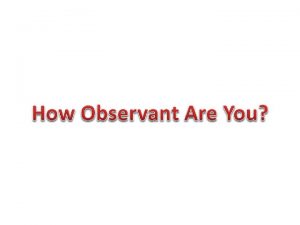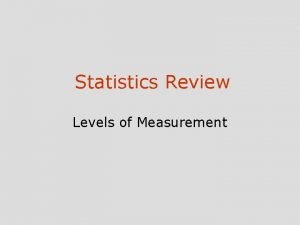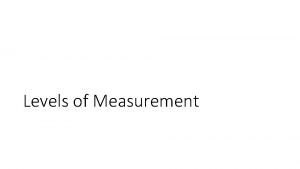Data Analysis Levels of measurement Lots of lovely









- Slides: 9

Data Analysis: Levels of measurement

Lots of lovely data! Psychologists collect data in lots of different formats, just think about all the data we collected in the research circus.

The Level of Measurement There are four levels of measurement; nominal, ordinal, interval and ratio, (NOIR). We need to know whether the data is nominal, ordinal, interval and ratio because it determines the type of descriptive or inferential statistics that are appropriate. It’s really important to get it right or we might use the wrong statistical test and up with meaningless conclusions. The levels of measurement vary from the most precise to the least precise and this affects the type of statistics that are suitable.

Interval and Ratio data Interval and ratio data are the most precise They use standardised units where the intervals between data points are always exactly the same i. e. between 1 cm and 2 cm on a ruler there always 10 small intervals, called millimetres There are 10 millimetres between every centimetre on a ruler and this never changes.

Ratio Data Ratio data is special because zero means zero! There are no minus values. You can’t run a race in -65 seconds! Time starts with zero seconds and increases with each second, there is no negative time only positive time. Zero means the clock hasn’t been started yet! Some measurements don’t have a ‘true’ zero, they start at zero but this is simply an arbitrary starting point, e. g. temperature has meaningful minus degrees Temperature, therefore, cannot be called ratio data, it would be called interval data.

Ordinal data: Data points are ranked interval scores can be ranked from most to least, this is called collapsing the data, (from interval to ordinal) e. g. in a group of 10 participants, the person with the bottom score gets ranked as 1 and the person with the top score gets ranked as 10 however, once a person is given rank score we no longer know how big the gap is between their scores. For example, the intervals might be different now; the difference between the bottom (1) and second to bottom (2) scores might be only 3 seconds, but the difference between the top (10) and second to top (9) scores might be 15 seconds for all we know You can see now that ordinal data is not as precise as interval data and also that ordinal data cannot become interval data; we have started to lose some of the precision.

Ordinal data in psychology sometimes interval data is treated as ordinal as it can be hard to say whether the gaps between scores are actually a standard interval e. g. if someone remembers 12 items on a memory test is their memory three times as good as someone who remembers only 4 when someone rates themselves on a scale of 1 -10 for how messy they are, might one person’s 6 be another person’s 4? ratings scales such as a Likerts are generally be treated as ordinal data as the scales are relatively subjective However, many academics use rigorously standardised psychological measures using Likerts and class the data as interval if the scale has 7 or more points.

Nominal data: least precise counting up the number of times (frequencies) within a category sometimes called category data maybe we want to know how many people got an A grade, how many B grades, C grades etc From this we can’t tell who came top (ordinal) and we certainly can’t tell how many points they actually scored (ratio) We might count how passers-by give money to a homeless person versus walking straight past (givers/nongivers);

Which descriptive stats to use…. Having decided which level of measurement was used, you can now choose your descriptive statistics Measure of central tendency Measure of dispersion Nominal Mode Ordinal Median Interval/Ratio Mean Variation ratio Range and/or Standard (percentage interquartile deviation of non-modal range scores)
 I had ____ fish and ____ chips for dinner
I had ____ fish and ____ chips for dinner Have a lovely sunny day
Have a lovely sunny day Snow frost and sunshine lovely morning
Snow frost and sunshine lovely morning The voice of the swallow flittering calls to me
The voice of the swallow flittering calls to me Cinderella once upon a time there was a beautiful
Cinderella once upon a time there was a beautiful Gcse english language paper 1 question 2
Gcse english language paper 1 question 2 A lovely cashmere sweater was found torn to shreds
A lovely cashmere sweater was found torn to shreds How lovely is your dwelling place verse
How lovely is your dwelling place verse Good morning my student
Good morning my student What a lovely boy
What a lovely boy

















